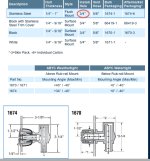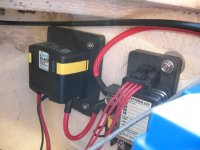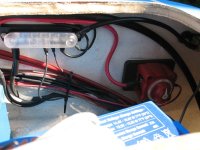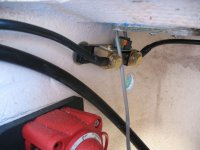Okay, so I decided that I needed to learn a bit more, and specifically to find out if my system was okay, since I already have it set up this way.
Before I start, I have to admit I have feelings of discomfort right at the moment. I know Dr. Bob has a vast amount of experience, more than I will ever have (and besides, electricals aren't my "thing" anyway), and I worry that it will seem like I'm contradicting him or being "uppity." That's not the case, but I fear it may seem that way (sometimes hard to convey things well in print). If I had consulted with him initially, I might have chosen a different system, but as it is I have what I have, and I wanted to know more about it, and whether it needed to be changed.
Second, I realize that Blue Sea is a company, and that they probably aren't going to tell me their stuff is bad; but on the other hand, most companies don't want you having a bad experience with their products, so from that angle I expected they would be straight with me. (Especially since I would just use new/different Blue Sea products if I changed things

)
I did some reading on the Blue Sea website, and although I saw some systems that were something like mine, there was nothing exactly like it (most were more complex/larger). I also wanted to ask them some specific questions. So I called and spoke with Aaron in their technical department. I let him know at the outset that I really liked Blue Sea products, and that it wasn't that I was unhappy with them, but rather that I wanted to ask him some questions about my specific use of them. I ran down my basic system and its components, including the outboard with the 20-amp alternator and the Victron monitor (which aren't Blue Sea of course). I don't know what his level of experience is, but I felt comfortable with what he was telling me, and he took plenty of time to answer several questions that I had. He also approved of the battery monitor (not Blue Sea). As a bonus, I think I figured out one "mystery" I had this summer.
So the upshot is that he felt my system should work well for my uses. I mentioned the "other" system (two matched batteries and a 1-2-Both switch) and he said that is another valid way to do it, but my focus was on what I have and whether I should change it or not. Now, everything I say from here on out is from my notes, and so please don't take it as gospel as it's possible I got some details wrong or am leaving something out.
First off, he said that they run systems (on larger boats of course) that have one start battery, and then multiple house batteries, and the two banks have different sized batteries and it works out okay. What he cautioned against is different sized batteries within a bank, because the smaller/weaker one can act as a weak link and drag the rest of the bank down. As I understand it now, the ACR doesn't so much direct charging, as it does "bar the door" to discharge if/when one battery is in danger of getting too low. The ACR is an "intelligent switch" that combines the batteries when it sees one at 13 volts or over, and disconnects them when one is at 12.5 volts or lower. That way one battery/bank cannot drag down the other battery/bank. As far as overcharging the smaller battery, I guess that it's just like having the switch on both, and that the smaller battery just stops accepting charge when it gets full? Sorry, my notes are a bit unclear on this part except that apparently it's going to be okay (I guess I can't learn it all in one session :disgust)
I then asked about whether I should have a larger house bank. We talked about that for a bit, and about usage. I think the reason my initial consultant recommended the battery size I have is that I said that - at least initially - I wanted to be able to be self-sufficient with a combination of anchoring and motoring. In other words, I wanted to reasonably be able to charge my house bank back up without having a charger or a shorepower system (which I might add later though). I also didn't want to lug around extra weight in the lazarette if not necessary (say I had a 200 amp hour bank, and only used 25% of it so that I'd just be putting back my easily-attainable 50 amps, well then I'd be toting around an extra 100 amps worth of battery. I may start using the boat differently and want to change the house bank, but initially I wanted to set it up for simple usage and then see how I tend to go).
He did mention a couple of other smaller details that were useful to me. One is that the ACR can go into "lockout" mode. If it does this the light on the front will blink. This would happen, for example, if you drew your house battery WAY down, like to 10 volts. I'm going to have to read up on this as I don't totally understand the rest of my notes. Oops

The other thing is that the ACR draws a small current even when the battery switch is set to "off." He recommended that if I was going to not use the boat for a longer period of time (or just wanted to know I could turn it all off for sure), that I add a switch in the small negative wire that comes out the bottom of the ACR.
This last item I think solved a mystery that I had this summer. When installing the new electrical system, I had a "bright idea." You know how there is the trim/tilt switch on the side of the motor, and how you tend to use it when trailering, and then have to climb up into the boat, open the lazarette, turn on the switch, climb down, trim/tilt the motor, climb back up... etc.? Well, my first thought was to just put the On-Off-Combine switch where I could reach it from the ground, but that would still be problematic if I had a camperback, and I like the tidiness of having it in the lazarette, so... I thought well, why not wire the start battery to be "hot"? After all, neither me nor anyone else is likely to just run the trim switch endlessly, and then it would be so handy because I could just trim/tilt from the ground at will. So that's what we did. All was great and I was feeling just a tad proud of myself until I went to leave Washington and..... ahem, no power to the trim/tilt mechanism (until I combined the batteries). At the time I wondered if perhaps my Yamaha had some small parasitic load, although that seemed unlikely. I charged up the start battery, and decided to just go back to the "normal" way and wire it into the switch.
When I mentioned this to the fellow at Blue Sea after he told me about the ACR having a constant small draw, he said that likely that was what dragged down my small start battery. I think I will put that "kill" switch in the ACR wire, just so I can KNOW things are all "Off." I will also probably get a larger/new start battery - although not as large as the house battery. That said, I'll probably try the U-1 just to see, since I have it. Why not do an experiment since it's there (I do have a pull start on the Honda just in case!).
As usual, I might have forgotten something or misstated something. If so, my apologies. I do feel comfortable now with my system as it is, except that I think I do need to get either a stand-alone charger or a built in charger for when I'm not using the boat (which of course could be used at a dock too).
Okay, I've been writing up a post on my transom drain and will post it later - at least that's an area where I feel comfortable with what I'm doing!











